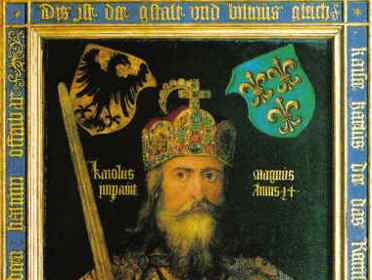Charlemagne’s Empire

Creation of Charlemagne’s Empire
Charlemagne’s empire or the Empire of Charlemagne refers to the Carolingian Empire during the rule of Charlemagne, also known as Charles the Great from 768 /771 to his death in 814. He created a realm larger than any in the West after the fall of Rome and paved the way for the rise of both the Kingdom of France and Holy Roman Empire. After his Imperial coronation by Pope Leo III in Rome in 800, he became viewed as the renewer of the Roman Empire and a rival to both the Roman emperors of antiquity and direct successors of the ancient Roman emperors – the Byzantine emperors in Constantinople. In addition to extending the territory of his realm over most Western and Central Europe, Charlemagne also initiated the Carolingian Renaissance, an intellectual and cultural revival that greatly influenced the Western culture.
Charlemagne’s Conquests
Charlemagne became co-ruler of the Frankish Kingdom with his brother Carloman after the death of his father Pepin the Short, the first King of the Franks from the Carolingian dynasty in 768. The relations between the brothers became very tense shortly after their father’s funeral and the war seemed inevitable when Carloman suddenly died in 771 leaving Charlemagne as sole ruler of the Realm of the Franks. Two years later, Charlemagne invaded the Lombard Kingdom on the appeal of Pope Hadrian I, captured the Lombard capital of Pavia and had himself crowned as King of Lombards in 774. At the same time he launched a campaign against the Saxons which ended with incorporation of Saxony into his empire in 804 and enforced Christianization of the Saxons. His campaigns in the east brought him Bavaria, Bohemia, Carinthia and the Danubian Plain, while the wars with the Muslim Moors in the Iberian Peninsula extended the Realm of the Franks to the Ebro River south of Pyrenees that came to be known as the Spanish March.
Charlemagne’s Rule
Despite a number of far-reaching reforms including governmental, Charlemagne’s empire was held together primarily by his military and political abilities although the repeated issuing of the so-called capitularies or instructions to his officials to carry out his wishes implies that the local leaders had their own will already during Charlemagne’s rule. He also followed the custom of the Frankish Kings who divided the realm among the male descendants and divided his empire among his three sons Charles the Younger, Pepin of Italy and Louis the Pious. However, the latter was granted the entire Charlemagne’s empire after the death of Pepin in 810 and Charles one year later except for Italy that went to Bernard, an illegitimate son of Pepin of Italy.
Division and Fall of Charlemagne’s Empire
The traditional division of the empire among the members of the Carolingian dynasty followed by Charlemagne as well as his successors proved to be the number one cause for the fall of Charlemagne’s empire. The civil war after the death of Louis the Pious in 840 and division of the Carolingian Empire into three kingdoms between Louis’ three sons with the Treaty of Verdun in 843 led to creation of the Realm of the Franks in the west that became the precursor of France and the Frankish Kingdom in the east or the precursor of the Holy Roman Empire as the central kingdom was divided between the western and eastern kingdoms in the 870’s. Charlemagne’s empire finally collapsed after the death of Charles the Fat in 888 who was the last from the Carolingian dynasty to rule the entire Carolingian Empire (from 884 to 887).




